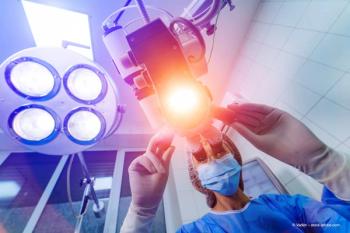
Use of retinal prosthesis system shapes vision for those with retinitis pigmentosa
The advent of a retinal prosthesis system offers a second chance at sight for patients with vision loss from retinitis pigmentosa.
Take home
The advent of a retinal prosthesis system offers a second chance at sight for patients with vision loss from retinitis pigmentosa.
By Thiran Jayasundera, MD, FACS, Special to Ophthalmology Times
Ann Arbor, MI-The advent of the retinal prosthesis system (
The system induces visual perception in blind individuals through the electrical stimulation of the retina, partially restoring a type of vision.
To qualify as a candidate for the system, patients must have been diagnosed with retinitis pigmentosa, be at least 25 years of age, have bare light or no light perception in both eyes, have previously had some sort of useful vision, and most importantly, must be willing and able to attend the pre and postoperative follow-up and rehabilitation sessions.
The system is comprised of both internal and external components. The external components include a pair of glasses (onto which a camera and antenna are mounted) and a video processing unit (VPU). A cable connects the glasses to the VPU.
The internal component is an epiretinal prosthesis that is implanted in and around the eye, typically the worse-seeing eye, and includes an antenna, an electronics case, and an electrode array.
The components work together to bypass the damaged photoreceptors in the retina and stimulate the remaining retinal cells that will register the perception of patterns of light the users will learn to interpret. This system-while not restoring full sight or curing retinitis pigmentosa-is the first device that partially restores useful vision to these patients.
Preparing for implantation
Prior to surgery, patients will need to be seen to assess eligibility for the device, which should include an eye exam-including an assessment of residual vision, anesthesiology assessment, retinal photography, and optical coherence tomography.
It is also important to do an A- and B-scan ultrasound to measure the axial length of the eye and evaluate the retina for conditions that may prevent the implant from resting well against the retina.
Finally, patients need to be started on an oral antibiotic-such as moxifloxacin 400 mg daily-about 2 days prior to surgery.
While the medical preparations are necessary, the most important aspect of the implantation preparation is counseling. It is crucial that patients have realistic expectations of the outcome of this procedure. Along with needing to understand all the risks and probable benefits of having the system implanted, patients must understand that post-implantation they will experience a visual perception that is different from the type of vision they had before they lost their sight. This is important in order to manage the patients’ expectations.
Patients will not wake from the surgery suddenly able to see. They must first learn to interpret the images they will perceive. This involves fitting or customized programming of the device and low-vision rehabilitation.
The experiences of individuals using the system will vary. Many express joy at being able to detect light patterns and motion after years of being blind. Users have also been able to identify different sources of light, locate items in front of them on a table, detect poles and other objects in their path, follow a sidewalk or crosswalk, determine where people are located, and even sort light and dark colored laundry or read large print words. While the system will not restore normal sight, it can provide users with a form of artificial vision that can enhance their connection to their surroundings and the people in their lives.
Surgical procedure overview
Two key aspects of this surgery are to focus on the accuracy of the device placement and to ensure that the sclerotomy is well closed. Each surgical step should be done with the precision prescribed by the manufacturer so no errors are made.
Sutures should be placed only once. It is necessary to be meticulous in terms of surgical technique and ensure thorough removal of the vitreous (and membrane, if present) during the time of vitrectomy. Unlike other surgeries, errors may be more difficult to correct with this procedure.
The surgery is administered under general anesthesia and patients also need an antibiotic given intravenously during the surgery. Once it has been established that the implant is in working order, the eye that will receive the implant is prepped and draped, a 360° conjunctival peritomy is made, and the muscles are isolated.
The extraocular portion of the implant is passed around the eye, underneath the rectus muscles. Before suturing the tabs, ensure that the implant is the correct distance from the limbus and that the suture tabs are in the prescribed position such that the cable falls smoothly onto the surface of the cornea. This will make placing the array over the macula much easier.
The implant is inserted through a 5-mm linear incision that is made in the superior temporal quadrant. To facilitate placement, the tip of special tack forceps can be used-without touching the retina-to move the array into position before it is tacked down. The tack injector is inserted through a 19-gauge sclerotomy and the array is tacked onto the macula. The ideal position for the array is such that it is centrally placed on the macula (Figure 1).
The sclerotomy is closed with a horizontal mattress suture, which goes underneath the cable, and a 9- × 5-mm pericardial graft placed on top of the case and the cable and sutured to the sclera. The Tenons are closed and sutured in all four quadrants and once the conjunctiva is closed, the subconjunctival dexamethasone and antibiotics are injected.
What patients experience
Patients will need the typical drops that are given after vitrectomy surgery-which is prednisolone acetate drops four times a day, antibiotic drops four times a day, and atropine drops twice a day.
After surgery is when the real work begins. The patient generally returns the day after surgery, a few days to a week later, and again a month later for medical follow-ups, to have their new device fitted, and to begin training and rehabilitation.
Typically 1 to 2 weeks after surgery, they have what is essentially a fitting session where the device is turned on and the thresholds of the electrodes are measured. The electrodes are stimulated to see if the patient detects any perceptions of light. People usually perceive the sensation of light or a flashing light. Over time, they will learn to interpret these patterns of light as shapes and objects.
About 2 weeks to 1 month after surgery, the external equipment-including the VPU and the glasses that contain the camera-are given to the patients and they will begin low-vision rehabilitation. Low-vision therapists will teach patients how to use their device, including how they can move their heads in order to scan an object. These therapists will help patients learn to interpret what they are seeing. The number of sessions a patient requires will vary, but in general, they could require from five to 12 sessions of therapy.
At each session they learn something new. During their first session, they will learn the basics, including how to put the glasses on and change the battery. From there, they learn how best to use the device, including how to move their heads in order to use the camera on the glasses to scan the presence or absence of an object that is in front of them.
At these sessions, the patients are given many different tasks to help facilitate the integration of the system into their lives. These tasks include activities, such as sorting black-and-white shapes, determining if a light is being turned on or off, and other exercises that are designed to help the patients interpret what they are seeing. A lot of these tasks can and should be performed at home as well, and the patient is provided a take-home kit to facilitate this process.
The more patients are willing and able to practice the exercises they are given in their low-vision therapists’ offices in their home environment, the faster they will learn to utilize their new sight. Those who are dedicated to practicing learn very quickly. Once patients have completed their training and learned to interpret the information provided by the system, they will be able to utilize their newfound visual functionality in their everyday lives.
Continued updates to the system hardware and software are likely to enhance their experiences going forward. While experiences will vary between patients, there is no doubt the system will continue to be a light in the darkness for those suffering from this degenerative disease.
Thiran Jayasundera, MD, FACS, is assistant professor of ophthalmology and visual sciences at the University of Michigan Kellogg Eye Center of Ann Arbor, a Fellow of the American College of Surgeons, Fellow of the Royal College of Surgeons of Canada, and Fellow of the Royal Australia and New Zealand College of Ophthalmologists. Dr. Jayasundera can be reached at
Newsletter
Keep your retina practice on the forefront—subscribe for expert analysis and emerging trends in retinal disease management.











































